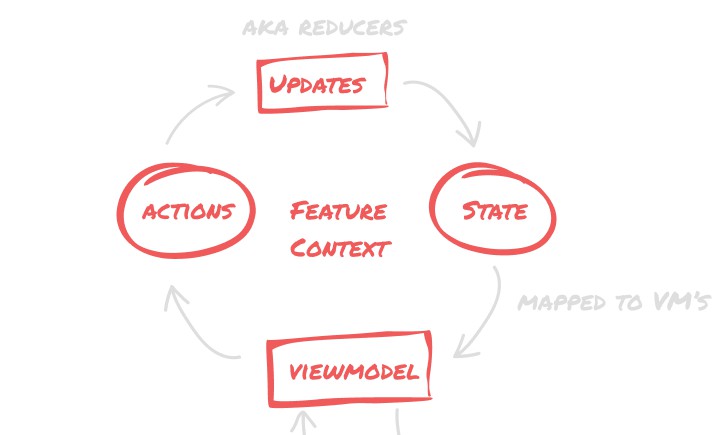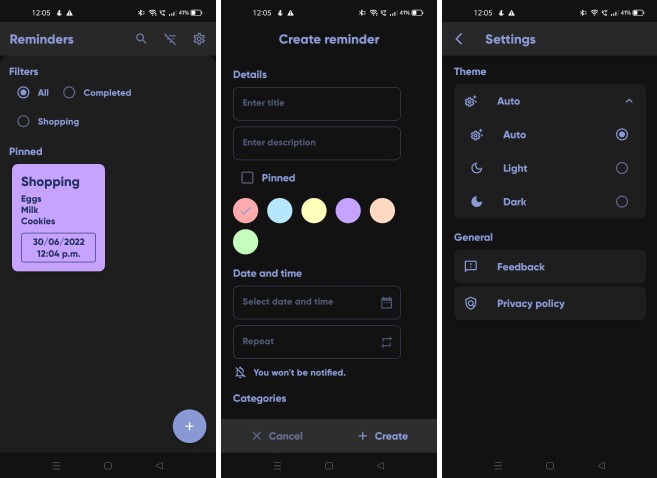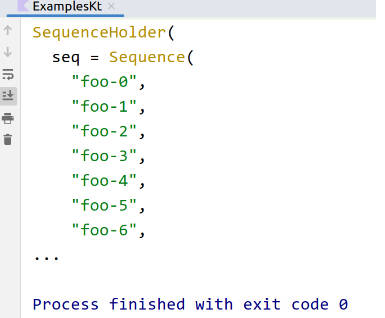Redukks
A simple, type-safe, and testable redux/uniflow implementation for Kotlin Multiplatform
A set of simple type-safe abstractions needed to implement Redux-like architecture on Kotlin Multiplatform. It simplifies the creation of stores, reducers and actions, and provides a simple way to test them.
Why Redukks?
While there are many redux implementations for Kotlin/Kotlin Multiplatform, most of them are either too complex, or too simple. Either the naming is too “reduxy”, the implementation is a wrapper around a “when” statement, or the abstractions are too complex to be written on the regular. I’ve found myself re-using the same set of abstractions through the years, so now I’ve decided to make them into a library I can both re-use and share.
The goal is to provide simple, type-safe, and testable abstractions for redux-like architecture, while still not tying you completely to a single pattern, providing you with abstractions that can help you build your own solution.
How redux works?
Quickstart
- Add the dependency to your project
repositories {
maven { url 'https://jitpack.io' }
}
dependencies {
implementation 'com.ianrumac.redukks:0.1.0'
}
- Define a state type and it’s updates
data class CountState(val total: Int)
sealed class Updates(override val reduce: (CountState)->CountState) : Reducer<CountState> {
class Add(val number: Int) : Updates({
state.copy(state.total+number)
})
class Subtract(val number: Int) : Updates({
state.copy(state.total-number)
})
}
- Create a
FeatureContextclass that contains all the dependencies for your feature.
interface CountContext {
val client : CountingAPI
val store: Store<CountState>
}
- Define
Actionsthat can be executed on the context
sealed class Actions(override val execute: suspend CountContext.()->Unit) : TypedAction<CountContext> {
class AddToClient(val number: Int) : Actions({
//here, we have access to all the CountContext properties that are captured during execution
//For example, we can access the store and update it with the result of the network call.
val result = client.add(number)
state.update(Updates.Add(result))
})
class SubtractFromClient(val number: Int) : Actions({
val result = client.subtract(number)
state.update(Updates.Subtract(result))
})
}
- Execute actions on the context
data class CountWithAnAPI(val scope: CoroutineScope) : CountContext {
override val client = CountingAPI()
override val store = reducedStore(CountState(0))
override val handler = actionHandlerFor(scope, this) //this is a coroutine scope that will be used to execute the actions
}
val context = CountWithAnAPI(scope)
context.handler.dispatch(Actions.Add(1))
- To make it easier to read, you can define it all under a context interface:
interface CountContext {
val client : CountingAPI
val store: Store<CountState>
val handler: ActionDispatcher<Actions>
data class CountState(val total: Int)
sealed class Updates(override val reduce: (CountState)->CountState) : Reducer<CountState> {
class Add(val number: Int) : Updates({
state.copy(state.total+number)
})
class Subtract(val number: Int) : Updates({
state.copy(state.total-number)
})
}
sealed class Actions(override val execute: suspend CountContext.()->Unit) : TypedAction<CountContext> {
class AddToClient(val number: Int) : Actions({
//here, we have access to all the CountContext properties that are captured during execution
//For example, we can access the store and update it with the result of the network call.
val result = client.add(number)
state.update(Updates.Add(result))
})
class SubtractFromClient(val number: Int) : Actions({
val result = client.subtract(number)
state.update(Updates.Subtract(result))
})
}
}
- Now, you can use the context to execute actions, and listen to state changes:
val context = CountWithAnAPI(scope)
val handler = context.handler
handler.dispatch(Actions.AddToClient(1))
context.store.listen().collectLatest { state ->
//do something with the state
}
For Android developers
You can use Redukks with Android’s ViewModel easily. You can collect the store as a StateFlow or use it with LiveData.
Your ViewModel can also implement Dispatcher<Actions> so you can dispatch the actions upstream.
You can also create abstractions for this such as a ReduxViewModel that handle these things for you.
Using it with a viewmodel is simple:
@HiltViewModel
class CountViewModel @Inject constructor(val actionHandler: Dispatcher<CountContext.Actions>,
val store: Store<CountContext.State>) : ViewModel(), Dispatcher<Actions> by actionHandler {
//Note: Not a real implementation, be careful where you collect and map your state
val state = store.listen().map(this::mapToViewModel).stateIn(viewModelScope, SharingStarted.WhileSubscribed(), initialValue = CountVM(0))
fun mapToViewModel(it: CountContext.State) : CountVM {
...
}
}
You can also control the lifecycle of your state by hoisting it up or down in the lifecycle scope tree. i.e. if you need to share a state store, you can just move it up from i.e. a fragment scope to an activity scope and pass it downwards to the fragments. This way, you can share the state between fragments, but still have only a single state store. You can even provide multiple stores, i.e.
typealias CountStore = Store<CountState>
typealias UserStore = Store<UserState>
interface CountContext {
val countStore: CountStore
val userStore: UserStore
}
class AuthenticatedCounterContext(userStore: UserStore) {
override val userStore = userStore
override val countStore = CountStore(CountState(0))
}
//...
class AddForUser : Actions({
val count = countStore.state.total
countStore.update(Updates.Add(1))
userStore.update(UpdateStateForUser(countStore.total))
})
This works beautifully with Jetpack Compose, since you can easily derive the UI from the state (please, map it to a viewmodel before doing so).
General Usage
Since Redukks is a modular set of abstractions, you can use only the parts you need for the complexity level you want. Redukks provides a few default implementations of the abstractions, but you can easily create your own.
Let’s start with the simplest case, a simple store. We’ll start with a simple counter implementation, with only a store without reducers or actions.
data class CountState(val total: Int)
val store = BasicStore(CountState(0))
store.update {
it.copy(it.total+1)
}
println(store.state.total) //prints 1
store.listen().collectLatest { state ->
//do something with the state
}
Now, we can also use a reducer to define state updates in a typesafe way.
So let’s create a reducer. Reducers are just objects that implement the Reducer<StateType> interface,
meaning they have a reduce closure that takes in the current state and returns a new state.
It’s like writing
fun addNumber(number: Int) {
store.update { state -> state.copy(state.total + number) }
}
but with a bit more type safety, so that you can be certain all possible state changes are predefined and tested.
sealed class Updates(override val reduce: (CountState)->CountState) : Reducer<CountState> {
class Add(val number: Int) : Updates({
state.copy(state.total+number)
})
class Subtract(val number: Int) : Updates({
state.copy(state.total-number)
})
}
Now, to use this reducer, we need to create a ReducedStore<StateType, ReducerType>. This is a store that can only be updated
via the defined reducer type. A default implementation is provided as BasicReducedStore, but you can easily create your own.
val basicStore = BasicStore(CountState(0))
// you can either provide it with a store or the initial state to use a BasicStore
val store = BasicReducedStore<CountState,Updates>(basicStore)
//or use the helper function
//val store = createReducedStore<CountState,Updates>(CountState(0))
store.update(Updates.Add(1))
store.listen().collectLatest { state ->
//do something with the state
}
Actions
Actions are asynchronous pieces of code that can be executed. Usually they are used to perform side effects, like network calls, or to dispatch other actions and updates. For example, fetching a list of items from a server, and then dispatching an action to update the state with the result.
Actions are a bit more complicated, since they usually need to be able to access dependencies.
To do this, we provide a <Context> that contains all the dependencies, and then create actions that
are executed with context as a receiver, meaning they have access to it as this.
With this, we can dispatch them to a Dispatcher<ActionType>, which should handle actions.
A basic coroutine based action handler is implemented by default under TypedActionHandler and
a custom one can be easily implemented by providing a Dispatcher<ActionType> or AsyncDispatcher<ActionType> for more
execution control (via Deferred). Also, provided is a AsyncAction class that can be used to simply pass
the closure via constructor.
Now, let’s see how to define async actions.
First, we need a context that these actions can be executed on.
While for simple cases (i.e. simply updating the store) you can just use a Store<StateType>, it’s better to create a custom context.
This gives you an easy way to access dependencies, mock them, replace them, etc. Also, it’s a good practice to keep
the actions tightly coupled to them, so that you can easily see what actions need what dependencies.
With Kotlin’s context receivers on the way, the code can be even cleaner in the future, removing the need for actions entirely and just implementing simple functions upon the receivers. But since most codebases don’t have context receivers yet, we’ll focus only on this implementation for now.
First, we define a CountContext interface that contains the dependencies we need:
interface CountContext {
val client : CountingAPI
val store: Store<CountState>
val handler: Dispatcher<Actions>
}
Then, we can define Actions via sealed classes that implement TypedAction<CountContext>:
sealed class Actions(override val execute: suspend CountContext.()->Unit) : TypedAction<CountContext> {
class Add(val number: Int) : Actions({
//here, we have access to all the CountContext properties that are captured during execution
//For example, we can access the store and update it with the result of the network call.
val result = client.add(number)
state.update(Updates.UpdateState(result))
})
class Subtract(val number: Int) : Actions({
val result = client.subtract(number)
state.update(Updates.UpdateState(result))
})
}
Now, we can implement the context and use the dispatcher to execute actions:
data class CountWithAnAPI(val scope: CoroutineScope) : CountContext {
override val client = CountingAPI()
override val store = BasicReducedStore<CountState,Updates>(CountState(0))
override val handler = TypedActionDispatcher(scope, this)
}
context.handler.dispatch(Actions.Add(1))
context.handler.dispatch(Actions.Subtract(1))
Testing
Testing is quite easy, for both reducers and actions. For reducers, you can simply create a state and a reducer,
i.e. val state = CountState(0) and val reducer = Updates.Add(1), and then call reducer.reduce(state).
Now you can assert that the result is the expected one.
@Test
fun `update the total count by adding 1`() {
val state = CountState(0)
val reducer = Updates.Add(1)
val result = reducer.reduce(state)
assertEquals(1, result.total)
}
For actions, you can create a context and a dispatcher, i.e. val context = CountWithAnAPI(TestCoroutineScope())
and val action = Action.Add(1), and then call action.execute(context).
This provides you with an easy way to test actions, since you can easily mock the context and assert that the
actions are executed as expected or use mocking libraries such as MockK to verify mocks executed properly.
@Test
fun `update the total count and add from client`() = runTest {
val context = CountWithAnAPI(this)
val action = Actions.Add(1)
action.execute(context)
assertEquals(1, context.store.state.total)
}
Customization
Each component is written in a way that allows for easy customization, so that you can easily create your own. Meaning by implementing a Store or a Dispatcher, you can easily have things like an API/Socket/Room backed store, or Actions that signal when they are done, or other Flows in your store. Don’t be afraid to customize the pattern to your needs – we’re not writing code to satisfy the patterns, we’re writing it for ourselves, our teammates and our users.
Contributing
Feel free to open an issue or a PR if you have any suggestions or improvements.





